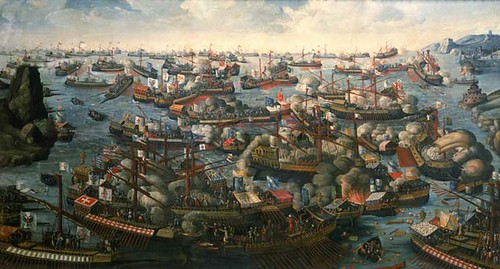The Christian fleet formed up in 4 divisions in a North-South line. At the northern end, closest to the coast, was the Left Division of 53 galleys, mainly Venetian, led by Agustino Barbarigo, with Marco Querini and Antonio da Canale. The Centre Division consisted of 62 galleys under Don Juan himself, along with Sebastian Veniero and Marcantonio Colonna. The Right Division to the south consisted of another 53 galleys under Giovanni Andrea Doria. Two galleases were positioned in front of each main division. A further Reserve Division was stationed behind (that is, to the west of) the main fleet, to support wherever it might be needed. It consisted of 38 galleys - 30 behind the Centre Division commanded by Alvaro de Bazán and 4 behind each wing. A scouting group was formed from 2 Right and 6 Reserve galleys. As the Christian fleet was slowly turning around Point Scropha, Doria's Right Division at the off-shore side was delayed at the start of the battle, and the Right's galleases did not get into position.
The Turkish fleet consisted of 54 galleys and 2 galliots in its Right, or northern, division, under Chulouk Bey, 61 galleys and 32 galliots in the Centre under Ali Pasha and about 63 galleys and 30 galliots in the South off-shore, under Uluj Ali. A small reserve existed of 8 galleys and 22 galliots and 64 fustas behind the Center body.
The Left and Centre galleases had been towed half a mile ahead of the Christian line, and were able to sink 2 Turkish galleys and damage some more before the Turkish fleet left them behind. As the battle started, Doria found that Uluj Ali's galleys extended further to the south than his own, and so headed south to avoid being out-flanked. This meant he was even later coming into action. He ended up being outmanoeuvered by Ali, who turned back and attacked the southern end of the Centre Division taking advantage of the big gap that Doria had left.
In the North Chulouk Bey had managed to get between the shore and the Christian North Division with six galleys, and early on, the Christian fleet suffered. Barbarigo was killed by an arrow, but the Venetians held their lines. The Christian Center also held the line and caused great damage to the Muslim Center. In the South off-shore side, Doria was engaged in a melee with Uluj Ali's ships taking the worse part, meanwhile Uluj Ali commanded 16 galleys in a fast attack on the Centre, taking 6 Christian galleys, between them the Capitana of Malta, from the Knights Hospitallers, killing everybody on board. The arrival of Alvaro de Bazán with the reserve was able to turn the battle, both in the Centre and in Doria's South wing. Uluj Ali was forced to flee with 16 galleys and 24 galliots, abandoning his captures. During the course of the battle, the Ottoman commander's ship was boarded and the Spanish tercios from 3 galleys and the Turkish janissaries from 7 galleys fought on the deck of the Turkish Sultana. Twice the Spanish were repelled with great loss, but at the third attempt, with reinforcements from Alvaro de Bazán's galley, they prevailed. Müezzenzade Ali Pasha was killed and beheaded, against the wishes of Don Juan. However, when his head was displayed on a pike from the Spanish flagship, it contributed greatly to the destruction of Turkish morale. The battle concluded around 4 pm.
The Turkish fleet suffered the loss of about 180 galleys and 60 galliots. However, only 117 galleys and 13 galliots were in good enough condition for the Christians to keep. On the Christian side 15 galleys were destroyed and 30 damaged so much they had to be scuttled.
The Holy League had suffered around 9,000 casualties but freed twice as many Christian prisoners. Turkish casualties were around 30,000.
From 12,000 to 15,000 Christian rowers, slaves on the Turkish Gaileys, were delivered. Though this Victory did not accomplish all that was hoped for, since the Turks appeared the very next year with a fleet of 250 ships before Modon and Cape Matapan, and in vain offered battle to the Christians, it was of great importance as being the first great defeat of the infidels on the sea.
Held by the Venetians from 1687 to 1689, and thence by the Turks until 1827, it became in the latter year part of the new Greek realm. Today Nafpaktos (Naupactus,) chief town of the district in the province of Arcarnania Aetolia, has (12,000 inhabitants), all Orthodox Greeks.

Gates of Vienna is thinking about it as well.









No comments:
Post a Comment